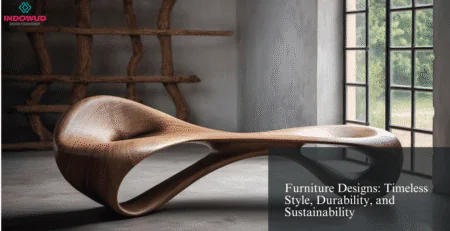Indowud: The Silent Hero of Sustainable Wood Architecture
indowud2025-01-28T05:50:23+00:00In an era where sustainable wood is no longer a choice but a necessity, Indowud emerges as a quiet yet transformative force in the world of architecture and design. Crafted from agricultural residues like rice husk, Indowud addresses some of the most pressing environmental challenges of our time, including air pollution, deforestation, habitat destruction, and species extinction.
This blog delves into how Indowud’s innovative approach contributes to sustainable architecture while mitigating these environmental crises.
The Environmental Challenges We Face
- Air Pollution and Parali Burning
Every year, millions of tons of agricultural residues, particularly paddy straw (parali), are burned in fields, releasing harmful pollutants like carbon monoxide, nitrogen oxides, and fine particulate matter (PM2.5) into the atmosphere. This practice not only causes severe air pollution but also contributes to smog formation in urban areas, impacting human health and exacerbating respiratory diseases.
- Deforestation and Habitat Loss
The demand for wood in construction and furniture industries has led to large-scale deforestation, destroying ecosystems that support countless plant and animal species. According to the United Nations, approximately 10 million hectares of forest are lost annually, which directly threatens biodiversity and accelerates climate change.
- Biodiversity and Animal Extinction
Forests are home to 80% of terrestrial wildlife. The loss of forest cover disrupts these habitats, pushing many species to the brink of extinction. For example, iconic animals like orangutans, tigers, and elephants are losing their homes to deforestation for timber production and agriculture.
- Climate Change
Deforestation contributes to nearly 15% of global greenhouse gas emissions. Forests act as carbon sinks, absorbing CO2. When trees are felled, this stored carbon is released, amplifying global warming.
Indowud’s Role in Tackling These Issues
Indowud is not just a building material—it is a movement towards sustainability. Here’s how it addresses key environmental concerns:
- Mitigating Air Pollution
Indowud utilizes rice husk, an agricultural residue often burned in fields, causing significant air pollution. By repurposing this waste, Indowud not only prevents harmful emissions but also adds economic value to agricultural by-products, benefiting farmers and reducing reliance on environmentally damaging practices.
- Reducing Deforestation
Traditional wood-based materials like plywood and MDF require timber from forests, contributing to deforestation. Indowud is a natural fiber composite (NFC) made entirely from non-forest resources. Every panel produced saves trees, preserving forests that are vital for climate regulation, biodiversity, and livelihoods.
- Supporting Biodiversity
By reducing deforestation, Indowud indirectly helps protect habitats and the species that depend on them. This preservation is critical for maintaining ecosystem balance and preventing the extinction of endangered animals and plants.
- Combatting Climate Change
Indowud’s production process is low-emission compared to traditional wood manufacturing. By utilizing agricultural residues and avoiding deforestation, Indowud significantly reduces its carbon footprint, making it an environmentally friendly choice for architects and builders.
Indowud’s Features: A Perfect Fit for Sustainable Architecture
- Durability and Longevity
Indowud panels are termite-proof, waterproof, and fire-retardant. Their durability ensures long-term use, reducing the need for frequent replacements and minimizing resource consumption.
- Zero Formaldehyde Emissions
Unlike traditional MDF and plywood, which use adhesives that release volatile organic compounds (VOCs), Indowud is free from harmful chemicals. This ensures better indoor air quality and a healthier living environment.
- Versatile Applications
Indowud is suitable for a wide range of applications, including furniture, decking, wall cladding, and jaalis. This versatility allows it to replace wood in multiple domains without compromising aesthetics or performance.
- Certified for Green Building
Indowud’s eco-friendly credentials, such as being EPD-verified, make it ideal for green building certifications like LEED. This encourages more architects to choose sustainable materials for their projects.
Real-World Impact of Choosing Indowud
- Urban Spaces
In urban environments plagued by air pollution, Indowud’s use prevents parali burning, improving air quality and public health. Its termite-proof and waterproof properties make it ideal for outdoor installations, ensuring durability in harsh city climates.
- Eco-Friendly Homes
For homeowners seeking sustainability, Indowud offers a guilt-free alternative to wood. Its aesthetic versatility allows it to mimic traditional wood finishes while being kinder to the environment.
- Large-Scale Projects
Indowud is an excellent choice for large-scale infrastructure projects aiming for green certifications. By incorporating Indowud, developers can reduce the environmental impact of their projects and set a precedent for sustainable construction practices.
Embracing Sustainability As Consumers
To embrace sustainability, consumers can make impactful choices by opting for Indowud products in construction and renovation projects, supporting brands committed to eco-conscious practices. Industry professionals can lead the way by advocating for sustainable materials like Indowud in their designs and educating clients on the environmental and performance advantages of these alternatives.
Meanwhile, community members play a vital role by raising awareness about the adverse effects of deforestation and air pollution and backing policies that encourage the use of sustainable materials and reforestation initiatives. Together, these collective efforts can drive meaningful change towards a more sustainable future.
Conclusion: A Silent Hero in the Fight for Sustainability
Indowud exemplifies how innovation can address pressing environmental challenges without sacrificing performance or aesthetics. By choosing Indowud, you are not just opting for a durable and stylish material; you are contributing to a global movement to combat air pollution, preserve biodiversity, and protect the planet for future generations.
In the story of sustainable architecture, Indowud is the silent hero—transforming waste into value, challenges into opportunities, and traditional practices into sustainable solutions. Let’s embrace this change, one panel at a time












Leave a Reply